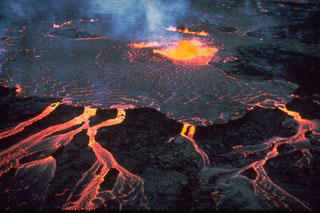Report on Kilauea (United States) — 9 January-15 January 2008
Smithsonian Institution / US Geological Survey
Weekly Volcanic Activity Report, 9 January-15 January 2008
Managing Editor: Sally Sennert.
Please cite this report as:
Global Volcanism Program, 2008. Report on Kilauea (United States) (Sennert, S, ed.). Weekly Volcanic Activity Report, 9 January-15 January 2008. Smithsonian Institution and US Geological Survey.
Kilauea
United States
19.421°N, 155.287°W; summit elev. 1222 m
All times are local (unless otherwise noted)
Based on overflights and web camera views when weather permitted, HVO reported that during 2-8 January activity from Kilauea's fissure segment D was concentrated at the Thanksgiving Eve Breakout (TEB) shield and satellitic shields to the SE. Lava flows were noted from the tops and flanks of the shields and traveled S and E. On 8 January, the SE-most shield breached on the SE flank and issued a vigorous and channelized 'a'a lava flow. The 'a'a flow advanced SE during 8-10 January and stalled approximately 480-650 m from the upper reaches of the Royal Gardens subdivision on 10 January. On 13 January, one of four narrow and secondary lava flows initiated from the 8 January 'a'a flow, advancing along the E margin to 180 m N of the subdivision.
According to a news article, most of the upper portion of the Royal Gardens subdivision was abandoned after lava flows cut the highway that provided access to the subdivision during Kilauea's ongoing 25-year eruption. County officials later cleared a path through the cooled lava for a few remaining residents.
Geological Summary. Kilauea overlaps the E flank of the massive Mauna Loa shield volcano in the island of Hawaii. Eruptions are prominent in Polynesian legends; written documentation since 1820 records frequent summit and flank lava flow eruptions interspersed with periods of long-term lava lake activity at Halemaumau crater in the summit caldera until 1924. The 3 x 5 km caldera was formed in several stages about 1,500 years ago and during the 18th century; eruptions have also originated from the lengthy East and Southwest rift zones, which extend to the ocean in both directions. About 90% of the surface of the basaltic shield volcano is formed of lava flows less than about 1,100 years old; 70% of the surface is younger than 600 years. The long-term eruption from the East rift zone between 1983 and 2018 produced lava flows covering more than 100 km2, destroyed hundreds of houses, and added new coastline.
Sources: The Honolulu Advertiser, US Geological Survey Hawaiian Volcano Observatory (HVO)

